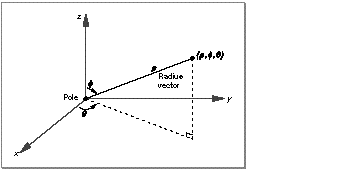
3D Graphics Programming with QuickDraw 3D 1.5.4
Previous | QD3D Book | Overview | Chapter Contents | Next |
Polar and Spherical Points
QuickDraw 3D defines polar and spherical points in the usual way. A polar point is a point in a plane described using polar coordinates. As illustrated in Figure 16 , a polar point is uniquely determined by a distance r along a ray (the radius vector ) that forms a given angle with a polar axis. Polar points are defined by the TQ3PolarPoint data type.
Given a fixed polar origin and polar axis, a polar point can be described by infinitely many polar coordinates. For example, the polar point (5, ) is the same as the polar point (5, 3).
Figure 16 A planar point described with polar coordinates

typedef struct TQ3PolarPoint {
float r;
float theta;
} TQ3PolarPoint;
- r
- The distance along the radius vector from the polar origin to the polar point.
- theta
- The angle, in radians, between the polar axis and the radius vector.
A spherical point is a point in space described using spherical coordinates. As illustrated in Figure 17 , a spherical point is uniquely determined by a distance along a ray (the radius vector ) that forms a given angle with the x axis and another given angle with the z axis. Spherical points are defined by the TQ3SphericalPoint data type.
Figure 17 A spatial point described with spherical coordinates

typedef struct TQ3SphericalPoint {
float rho;
float theta;
float phi;
} TQ3SphericalPoint;
- rho
- The distance along the radius vector from the polar origin to the spherical point.
- theta
- The angle, in radians, between the x axis and the projection of the radius vector onto the xy plane.
- phi
- The angle, in radians, between the z axis and the radius vector.
© 1997 Apple Computer, Inc.
Previous | QD3D Book | Overview | Chapter Contents | Next |